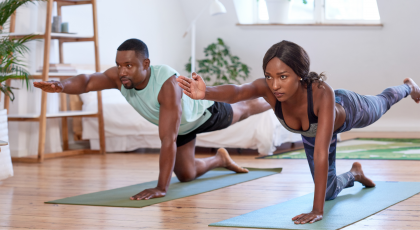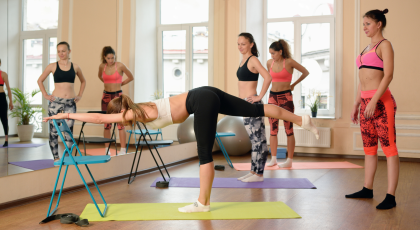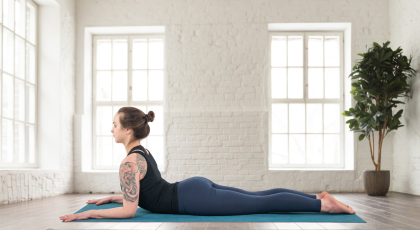View basket (0 items $0.00)

Chronic Pain? Try Isometric Contraction
In the past few years, more research has gone into the study of isometric muscle contraction and its relationship to pain relief. If that sentence made you say, “Huh?” Let´s back up and review.
3 Types of Muscle Contractions
Muscle contractions fall into 3 categories:
1. Concentric: The muscle is getting shorter—your biceps when you pick up your drink and bring it to your mouth.
2. Isometric: The muscle is staying the same length—your biceps when you hold your drink to take a sip.
3. Eccentric: The muscle is getting longer—your biceps as you lower your drink.
Eccentric vs. Concentric vs. Isometric Contraction
Previously, eccentric contraction got a lot of attention, because it´s been proven to help with tendon repair. We also know that an eccentric contraction loads the muscle more than a concentric contraction by about 40 percent. So eccentric contraction is a quicker way to build muscle strength.
However, newer research is finding that isometric contractions are an effective way to create pain-free muscle activation and start to rewire the brain´s pain messages about movement so that we can eventually break the pain cycle.
How to Practice Isometric Contraction
 So how do we put this into practice?
So how do we put this into practice?
Let’s say you’re working with someone who has pain in their shoulder when they lift their arm. Here’s how you can help:
-
Position yourself next to them, and then take their arm and move it up, without them “helping” with their arm muscles.
-
Once the arm is lifted, you gradually remove your support and instruct them to take over holding the arm in position.
-
After a few seconds, you would once again take over holding their arm up, they relax, and you support their arm back down.
-
In that way, the only time they are contracting their muscles is to hold their arm up, and that’s the isometric contraction.
Isometric Contraction Allows for Movement without Pain
 The big takeaway: when people have pain with movement, they often become afraid of that movement (kinesiophobia). From pain science research, we know that to get someone healthy and moving again, we must find pain-free ways for them to move. Research is starting to show that for some people, in some instances, an isometric contraction is the way to help them create movement without pain.
The big takeaway: when people have pain with movement, they often become afraid of that movement (kinesiophobia). From pain science research, we know that to get someone healthy and moving again, we must find pain-free ways for them to move. Research is starting to show that for some people, in some instances, an isometric contraction is the way to help them create movement without pain.
Ultimately, this will be an “it depends” situation. Some people will tolerate it, and some won´t. But it´s a great tool to add to your toolbox, especially if you are working with someone who is in pain and is now afraid to move.
 Dr. Sarah Court PT, DPT, E-RYT is a physical therapist, movement mentor, and yoga teacher trainer. She is the creator of Quantum Leap, a continuing education program and mentorship community that makes sophisticated concepts easy for movement teachers to understand and use in their work. She teaches public workshops and teacher trainings internationally, bringing together the worlds of yoga, strength, and neuromuscular exercise. Most recently, she creates yoga and movement content for the Headspace app. Sarah lives in Los Angeles and splits her time between teaching and clinical work.
Dr. Sarah Court PT, DPT, E-RYT is a physical therapist, movement mentor, and yoga teacher trainer. She is the creator of Quantum Leap, a continuing education program and mentorship community that makes sophisticated concepts easy for movement teachers to understand and use in their work. She teaches public workshops and teacher trainings internationally, bringing together the worlds of yoga, strength, and neuromuscular exercise. Most recently, she creates yoga and movement content for the Headspace app. Sarah lives in Los Angeles and splits her time between teaching and clinical work.
References:
1. Rio E, Kidgell D, Purdam C et al. Isometric exercise induces analgesia and reduces inhibition in patellar tendinopathy. Br J Sports Med. 2015 Oct;49(19):1277-83.
doi: 10.1136/bjsports-2014-094386.
2. Huang L, Gui B, Xu F, Zhao J. Effects of quadriceps functional exercise with isometric contraction in the treatment of knee osteoarthritis. Int K Rheum Dis. 2018 May;21(5):952-959.
doi: 10.1111/1756-185X.13082.
3. Hoeger Bement MK, Weyer A, Hartley S et al. Pain perception after isometric exercise in women with fibromyalgia. Arch Phys Med Rehabil. 2011 Jan;92(1):89-95.
doi: 10.1016/j.apmr.2010.10.006.
4. Lemley KJ, Drewek B, Hunter SK, Hoeger Bement MK. Pain relief after isometric exercise is not task-dependent in older men and women. Med Sci Sports Exerc. 2014 Jan;46(1):185-91.
doi: 10.1249/MSS.0b013e3182a05de8.
Featured Courses









